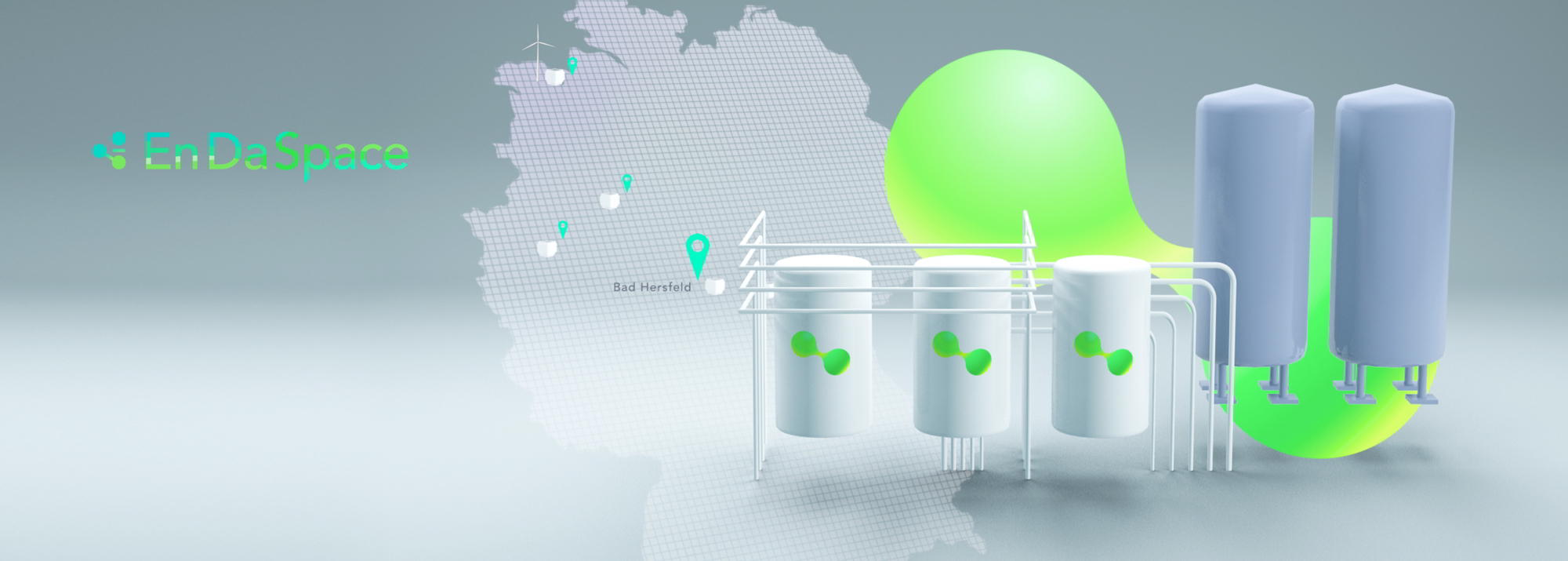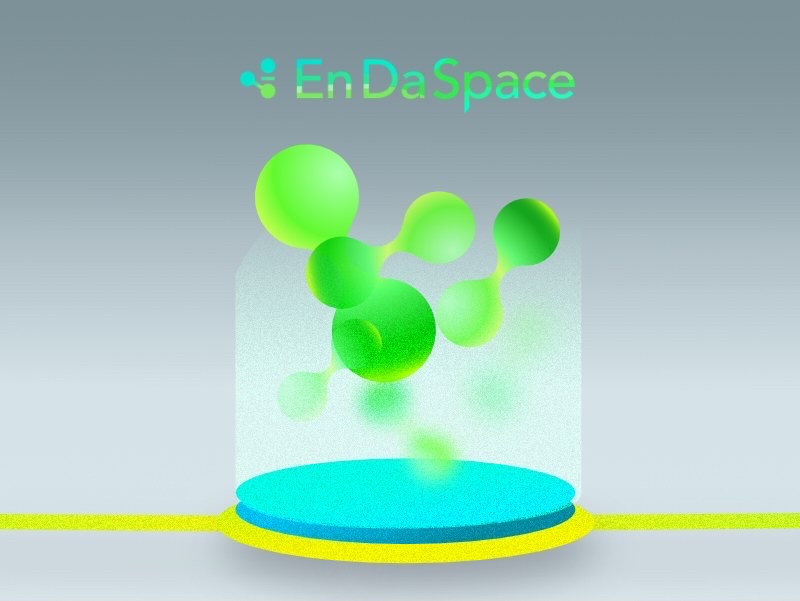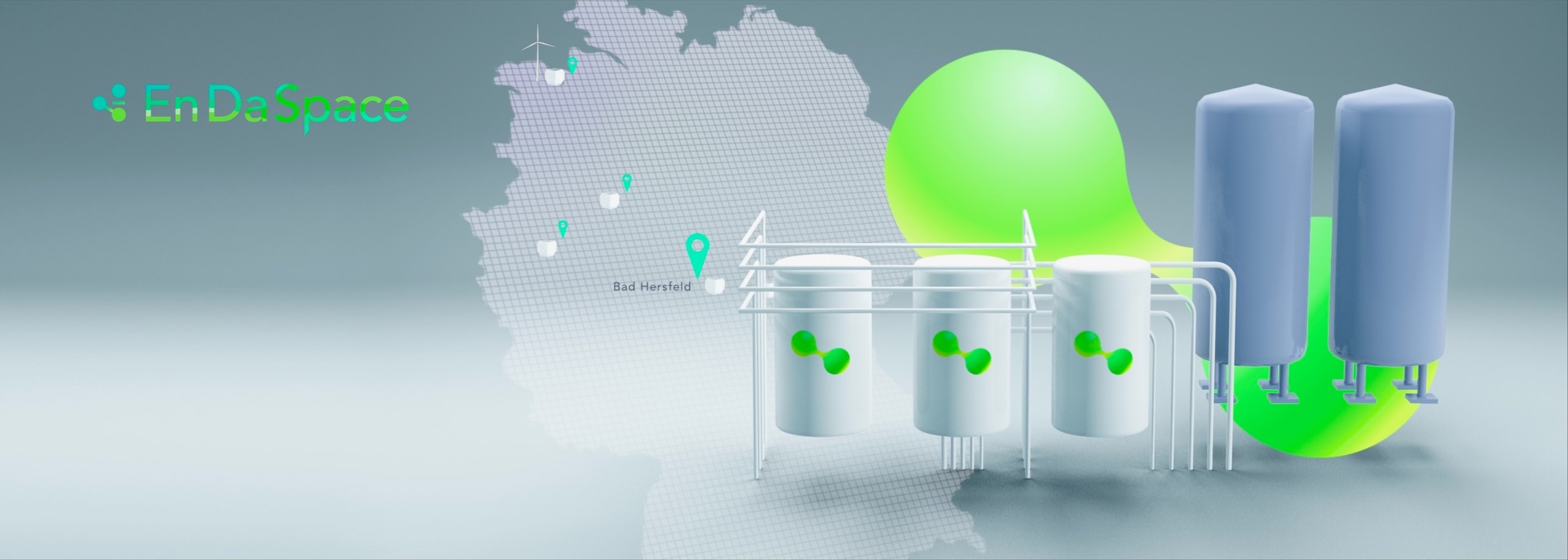Fraunhofer demonstrates how data spaces can serve the energy sector using the example of green hydrogen
The objective of a digitalized energy transition is to harness data provided by a variety of decentralized electricity producers, such as wind turbines or PV plants, and loads so that the electricity system can run efficiently. This huge need for information calls for new concepts to establish how data can be exchanged efficiently and how organizations can preserve their digital sovereignty. Through a pilot project looking at the production of green hydrogen, four Fraunhofer institutes have now shown how this could be implemented in future using the concept of the International Data Spaces (IDS). A video has been made that looks into the details of the project, which will also be presented in an expert web session on May 27.
The architectural framework of the IDS has been developed by Fraunhofer-Gesellschaft together with several industrial partners and realized in the form of concrete software modules. The gateway to the data space is an IDS connector, which implements the rules and processes that apply in the data space. These rules include terms and conditions for using the data, compliance with which can be implemented and tracked using technology.
There are also centralized services such as the certification of participants, the provision of search engines for data and metadata as well as other functions for documenting transactions (clearing house) or making applications available via an app store. The IDS modules and their functions fit into the concept of the European GAIA-X initiative, so are already capable of facilitating entry into the European data space of the future.
An energy data space as a tool for digitalizing the energy transition
“There is enormous potential for utilizing data space technology in the energy sector,” explains Volker Berkhout of Fraunhofer IEE, who headed up the “EnDaSpace” subproject. “Until now, it has not been possible to make use of the information available in various areas because organizations fear that sharing this data will put them at a disadvantage. In the future, we want to use an energy data space to open doors to collaboration that were previously closed.”
In the “EnDaSpace” project, data from the 8 MW wind turbine at Fraunhofer IWES in Bremerhaven, Germany, was used as the basis for producing green hydrogen at the Fraunhofer IEE power-to-gas research center in Bad Hersfeld, also in Germany. Each day, Fraunhofer IOSB-AST combined the data from the wind turbine with information about the weather and the electricity market to create a schedule for using wind power to produce hydrogen the next day. The operation management strategies implemented for electrolyzers in the energy system are becoming more relevant as the use of hydrogen increases, both in terms of how profitable projects are and how the complete system is operated.
Plants and systems communicate with one another via an energy data space, in which systems exchange data according to agreed rules and under specific conditions. The international data spaces concept allows all participants to make self-determined decisions about how their data is used, thus ensuring they retain their digital sovereignty.
The project partners are all agreed on the long-term prospects they see for this field: “For us, this successful pilot project of an example use case is the first step in designing an energy data space for a really wide variety of use cases in the energy sector.”
Data from an 8 MW wind turbine
The 8 MW wind turbine at Fraunhofer IWES in Bremerhaven provided the data for the pilot project. First of all, the operating data used in the project was aggregated for different time periods, before being linked to the connector via a REST interface and created as a data resource in the energy data space.
“We will be able to harness the knowledge and experience we have built up in this project to help other plant operators or software providers to prepare wind energy data and make it available for data spaces in the future,” explains Juliane Schneider, Research Fellow at Fraunhofer IWES, who led the work package.
Optimizing the schedule in a way that is economical and beneficial for the grid
The EMS-EDM PROPHET® energy management software from Fraunhofer IOSB-AST brings together information about wind turbine operation with weather forecasts and electricity market prices. The software then uses this data to calculate a schedule that ensures electrolysis will only be carried out when wind power is available and the electricity price is below a definable threshold at which feeding power into the grid is more profitable than electrolysis. Plant operation parameters are also taken into account when calculating schedules, such as the time taken to switch between states when switching on or in standby mode. In the future, the researchers plan to optimize the electrolyte’s mode of operation and integrate this into their models.
“We expect this issue to become more important over time,” says Carsten Frey, Research Fellow at Fraunhofer IOSB-AST. “We will use the work we have done so far as a basis for developing new balancing group management functions within our EMS-EDM PROPHET® energy market suite.”
Green hydrogen
A data format was agreed upon for using the schedule and the flow of data from the connector into the plant was designed and realized. The schedule is first written into a database, from where it is read out and implemented by the electrolyzer’s plant control system. A successful test run was carried out during a real-life operation at the Fraunhofer IEE power-to-gas research center in Bad Hersfeld at the end of February.
“Connecting up wind power and hydrogen both offshore and onshore will be an essential aspect of producing green hydrogen,” predicts Bernd Krautkremer, who is head of the research center in Bad Hersfeld. “It is often vital to consider how the hydrogen is going to be used afterward when optimizing operations.”
An open data platform
The EnDaSpace open data platform is based on a FIWARE instance provided by Fraunhofer IOSB-INA. FIWARE is an open-source initiative offering a modular kit for implementing and running data platforms. Its particular focus is on standards and solutions for managing context data. It was therefore easy to link an anomaly detection function executed on the data platform to the wind turbine’s operating data. The challenge of this project was to connect the flow of data via the IDS connectors to data management in the FIWARE environment.
“The combination of data spaces with established open platform technology is a market of the future,” predicts Anders Borcherding, Research Fellow at IOSB-INA. “We can see interesting opportunities for applications, especially in the field of smart cities.”

Privacy warning
With the click on the play button an external video from www.youtube.com is loaded and started. Your data is possible transferred and stored to third party. Do not start the video if you disagree. Find more about the youtube privacy statement under the following link: https://policies.google.com/privacyContact Energy Data Space
Volker Berkhout
Fraunhofer IEE
Telefon: +49 (0)561 7294 477
E-Mail: volker.berkhout@iee.fraunhofer.de
Technical Contact Energy Management Software EMS-EDM PROPHET®
Carsten Frey
Fraunhofer IOSB-AST
Telefon: +49 (0)3677 461 139
E-Mail: carsten.frey@iosb-ast.fraunhofer.de
About the project
The “EnDaSpace Platon” project was selected by Fraunhofer-Gesellschaft as part of its program to push innovation and ran from August 2020 to February 2021. Alongside the work to demonstrate the energy data space, the “Platon” subproject scientifically examined approaches to the platform economy in the energy sector. The Fraunhofer institutes IEE, IOSB-INA, IOSB-AST, ISST and IWES were involved in the EnDaSpace subproject.
A video about the energy data space and the content of this project will be published at the same time as this press release. The details of the project will also be presented in an expert web session on May 27 at 10:00 a.m. in collaboration with Fraunhofer Energy Intelligence (ENIQ). The video, the registration page for the expert web session and further information about the project are available on the www.energydataspace.de website.
More Information
- Projektseite EnDaSpace
- Expert-Web-Session EnDaSpace | Online-Veranstaltung 27. Mai 2021, 15:00-16:30 Uhr
- Fraunhofer-Institut für Windenergiesysteme (iwes.fraunhofer.de)
- Fraunhofer-Institut für Optronik, Systemtechnik und Bildauswertung IOSB (iosb-ast.fraunhofer.de)
- Institutsteil für angewandte Systemtechnik AST (iosb-ast.fraunhofer.de)
- Institutsteil für industrielle Automation INA (iosb-ina.fraunhofer.de)
- Fraunhofer-Institut für Software- und Systemtechnik ISST (isst.fraunhofer.de)
Last modified:


